
Three main types of canal were developed in Britain in the second half of the 18th century, namely broad canals, with locks 14 feet wide, narrow canals, with locks 7 feet wide, and tub-boat canals. The latter type of canal was developed to pass through land where the gradients were particularly steep and they were principally built in Shropshire and the South West. The boats used on these canals traversed steep gradients by way of inclined planes carried in cradles or caissons running on rails, those in Shropshire being fitted with cradles.
As early as the 1780s, canal engineers were searching for means of replacing flights of locks with other contrivances, such as lifts and inclined planes and for devices, such as cradles and caissons, to carry boats. Today, no inclined planes remain in working order on Britain's canal system but their remains, sometimes obscured by undergrowth and trees, can still be found here and there. Approximately 20 inclined planes were constructed in the South West alone, notably on the Bude and Torrington Canals and the Ridd inclined plane on the latter canal is particularly noteworthy.
The complex network of tub boat canals in Shropshire was characterised by their relatively short lengths. They were situated in the area of Shropshire now known as Telford and these were the Shrewsbury Canal (incorporating the Wombridge Canal), Duke of Sutherland's Canal (Donnington Wood Canal), Shropshire Canal and the Ketley Canal. Additionally, there were a number of branches and arms, namely, the Humber Arm, Coalbrookdale Branch (Horsehay Branch) and the Lilleshall Branch. The Pitchcroft Arm was off the Lilleshall Branch and it is known that there were a number of smaller arms off this branch but the location of these is unrecorded.
The main purpose of the tub boat canals in Shropshire was to transport coal, limestone and ironstone from mines and quarries to blast furnaces where it was used to smelt the ironstone to produce pig iron, which was then further processed to make cast iron and wrought iron.
The Shrewsbury Canal was constructed by Josiah Clowes and later by Thomas Telford and it contained his renowned iron aqueduct at Longdon-on-Tern. The pivotal link on the Shrewsbury Canal was Wappenshall Junction and from here in a north westerly direction the canal proceeded to Shrewsbury Basin. In a south easterly direction from the junction, the canal proceeded to Old Yard Junction at Donnington Wood where it joined the Shropshire Canal and the Duke of Sutherland's Canal (Donnington Wood Canal). The Wombridge Canal was incorporated at the end of the latter section of the Shrewsbury Canal. The Wombridge Canal was constructed in c.1888 and it was sold to the Shrewsbury Canal Company in 1792. As built, this 1¼ mile-long canal commenced at Old Yard Junction and its purpose was to transport coal and ironstone from Wombridge to blast furnaces at Donnington Wood. From Old Yard Junction, the Duke of Sutherland's Canal proceeded to Pave Lane while the Shropshire Canal proceeded to Coalport alongside the river Severn. The Ketley Canal commenced at a junction with the Shropshire Canal at Oakengates and it proceeded to Ketley Bank and Ketley Iron Works.
At first, there was no outlet to the rest of the canal system but in 1835 a connection was made by the construction of the Newport Branch, which commenced at Norbury Junction on the Shropshire Union Canal (Birmingham and Liverpool Junction Canal) and proceeded to Wappenshall Junction where it joined the Shrewsbury Canal.
Tub boats in Shropshire were rectangular in plan, 19 feet 9 inches long by 6 feet 2 inches wide made of wrought-iron plates rivetted together. An inclined plane consisted of two rails laid parallel to each other, on each of which ran a cradle raised or lowered by a wire rope and capable of carrying one tub boat at a time. The descending cradle assisted in balancing the weight of the ascending one and the extra power required was supplied by a stationary winding engine. A boat descending an inclined plane entered a chamber where it was manoeuvred over a submerged cradle. Once in place, the boat was secured to the cradle in readiness for its journey down the plane. The cradle was then hauled up over a sill and onto the plane, at which point it was still inside the chamber. When everything was ready it commenced its descent, which required just a few minutes, and a small number of workmen were able to complete the whole operation.
The best preserved is the Hay Inclined Plane at Coalport in Shropshire. Here there is a vertical difference in height of 213 feet between the two sections of the Shropshire Canal. At the lower level, goods were transhipped between tub boats on the canal and Severn trows/barges on the river Severn. Originally, there was a river lock making a connection between the canal and the river Severn but this was unsuccessful and it was filled in. The Hay Inclined Plane became disused around the turn of the 20th century following which the rails were ripped up and the associated buildings partially destroyed. Following the establishment of the Ironbridge Gorge Museums Trust in the early 1970s, the plane was cleared and the rails were replaced. Volunteer working parties from the Peak Forest Canal Society assisted with this work. Nowadays, a section of the Shropshire Canal and the inclined plane are contained within the Blists Hill Open-Air Museum. Unfortunately, the section of the Shropshire Canal within the museum is not maintained and it is now heavily overgrown.
The inclined plane on the Ketley Canal is commemorated on a halfpenny trade token dated 1792 (illustrated below, right). At this time the government was not issuing sufficient small coinage and employers were quick to exploit government inertia by issuing their own money in the form of trade tokens. Employees were paid using these tokens, which could only be spent at the company shop or exchanged for coins of the realm at some designated location.
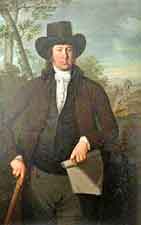 William Reynolds.
William Reynolds.The reverse of this token shows the chamber where a tub boat, either from the plane or from the canal, was manoeuvred off or onto the cradle, depending upon which way it was travelling. On the left an empty cradle can be seen at the top of the plane and on the right a workman seems to be operating a brake lever. This inclined plane was self acting where a descending loaded boat was counterbalanced by an ascending empty or lightly loaded boat. The movement of the cradles over the plane was regulated by a brake and it is possible that the large vertical wheel was a band brake.
William Reynolds, a Shropshire ironmaster from Ketley, surveyed and oversaw construction of the Ketley and Shropshire Canals but the exact date of their opening is uncertain. However, the trade token shows that the Ketley Canal was operational by 1789. Although this canal was only 1½-miles long the fall in height over its length was 74 feet. As a result of this, Reynolds' built what is believed to be Britain's first inclined plane with a difference in height of 73 feet. To accommodate the remaining 1 foot difference a lock was built above the plane. The purpose of this canal was to supply ironstone to Ketley Iron Works. In 1816 this works closed and thus the Ketley Canal became unused. It is believed that the inclined plane remained operational for another two years before it too closed.
 | 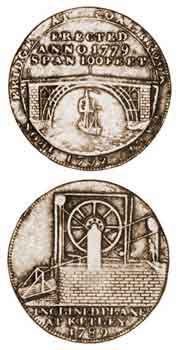 |
Hay Inclined Plane on the Shropshire Canal at Coalport, late 19th century. At the top of the plane the two chambers, where tub boats were manoeuvred onto cradles, can be seen and the large structure above housed the pulleys that were used to haul tub boats on the plane. The adjoining building on the right is the engine house and the chimney further to the right marks the location of the boiler house. |
1792 halfpenny trade token. The obverse depicts a boat, possibly a Severn trow, passing below the famed iron bridge at Coalbrookdale.
The wording above the bridge states, 'ERECTED ANNO 1779. SPAN 100 FEET.' Around the periphery it is worded, 'IRON BRIDGE AT COALBROOK DALE. 1792'.
The reverse depicts the top of the inclined plane on the Ketley Canal and below it is worded, 'INCLINED PLANE AT KETLEY 1789'. |
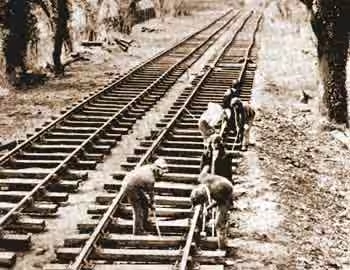 | 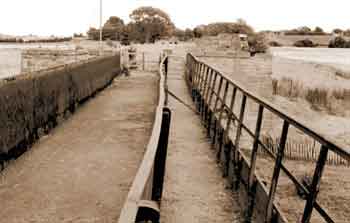 |
Hay Inclined Plane, Apr 1975. Members of a Peak Forest Canal Society Working Party are seen here helping to replace the rails on the incline. |
Longdon-on-Tern Aqueduct on the Shrewsbury Canal, Jul 1978. Thomas Telford built this famous aqueduct over the river Tern (a tributary of the Severn) and it is often claimed that it was the first to be built of iron plates bolted together. Nonetheless, this is incorrect as the first iron aqueduct was the Holmes Aqueduct on the Derby Canal, which was built by Benjamin Outram. This opened in February 1796 to be followed one month later by Telford's Longdon-on-Tern Aqueduct. |
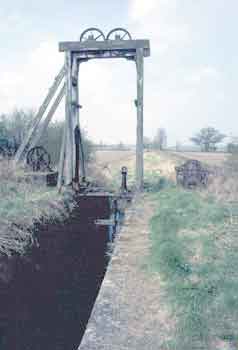 | 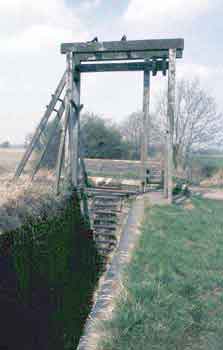 |
| Bottom guillotine gate of Turnip Lock at Hadley on the Shrewsbury Canal, 1985. | Bottom guillotine gate of Hadley Park Lock at Hadley on the Shrewsbury Canal, 1985. |
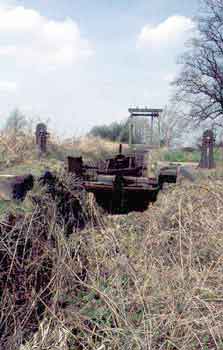 | 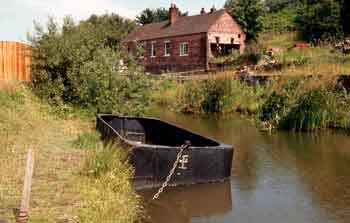 |
| Hadley Park Lock seen from above the top gate, 1985. | A tub boat moored on the Shropshire Canal at the Blists Hill site of the Ironbridge Gorge Museum Trust, 1982. It is moored a short distance away from the top of the Hay Inclined Plane at Coalport where there is a 213 feet height difference between the two sections of the canal. Writing in 1904, Henry Rodolph de Salis stated that there were only about 24 tub boats left. |
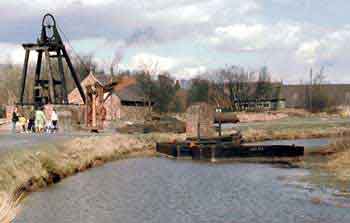 | 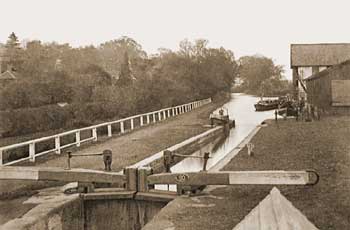 |
| Two tub boats on the Shropshire Canal at Blists Hill, 1982. | Lock 20, Newport Wharf (or Newport Town) Lock on the Newport Branch, early 20th century. |
Shropshire Tub Boat Canals » Schematic Diagram
Supplementary Details
The main purpose of this complex network of tub boat canals was to transport coal, limestone and ironstone from mines and quarries to blast furnaces where it was
used to smelt the ironstone and produce pig iron, which was then further processed to make cast iron and wrought iron.
Newport Branch
At first there was no outlet from the tub boat canals to the rest of the canal system but in 1835 a connection was made by the construction of the Newport Branch.
This branch commenced at Norbury Junction on the Shropshire Union Canal (Birmingham and Liverpool Junction Canal) and it proceeded by Meretown, Newport, Edgmond and Preston-upon-the Weald to Wappenshall Junction where it joined the Shrewsbury Canal.
It was 10½-miles long and there were 23 locks falling towards Wappenshall Junction. These were Norbury (5), Norbury (2), Forton (5), Forton (2), Forton (3), Meretown (1), Haycock's or Fisher's (1), Newport Wharf or Newport Town (1), Ticket House (1), Polly's (1) and Edgmond (1).
There were five aqueducts and these were at the River Meese, Strine Brook (2), Humber Brook and Crow Brook. The maximum size of boat that could use this branch was 72 feet long by 6 feet 10 inches wide.
Humber Arm
This arm commenced at a junction on the Newport Branch, two miles above Wappenshall Junction, and it proceeded to Lubstree Wharf.
The maximum size of boat that could use this arm was 72 feet long by 6 feet 10 inches wide.
Shrewsbury Canal (incorporating the Wombridge Canal) - Wappenshall Junction to Old Yard Junction
This is the earlier section of the Shrewsbury Canal. Commencing at Wappenshall Junction at the terminus of the
Newport Branch, this section of the canal proceeded by Hadley, Trench and Wombridge to Old Yard Junction at Donnington Wood where it joined the Shropshire Canal and the Duke of Sutherland's Canal (Donnington Wood Canal).
It was 3¾-miles long and there were nine locks and the Trench Inclined Plane, all rising towards Old Yard Junction.
Between Wappenshall Junction and Trench Wharf the locks were 71 feet long by 6 feet 2 inches wide and they could pass three tub boats at a time. Above Trench Wharf only tub boats could be used.
The Wombridge Canal was constructed in c.1788 but in 1792 William Reynolds sold it to the Shrewsbury Canal Company. It commenced at Old Yard Junction at a connection with the Shropshire Canal and the Duke of Sutherland's Canal and it was built to transport coal and ironstone from Wombridge to blast furnaces at Donnington Wood. It was 1¼-miles long.
Shrewsbury Canal Wappenshall Junction to Shrewsbury Basin
Commencing at Wappenshall Junction at the terminus of the Newport Branch, this section of the
canal proceeded by Eyton, Long Lane, Longdon-upon-Tern, Rodington, Withington, Upton Forge, Berwick Wharf, Uffington, Ditherington and Pimley to Shrewsbury Basin.
It was 14½-miles long and there were two locks falling towards Shrewsbury Basin. These were Eyton Upper and Eyton Lower.
There were two aqueducts and these were Longdon-on-Tern and river Roden. There was one tunnel and this was Berwick Tunnel (970 yards long). This tunnel was built with a towpath, which was removed in 1819.
Both locks on this section were 81 feet long by 6 feet 9 inches wide and they could pass four tub boats at a time.
Duke of Sutherland's Canal (Donnington Wood Canal)
This canal commenced at Old Yard Junction (Donnington Wood) and it proceeded by Muxton Bridge and
Lilleshall Abbey to Pave Lane by the Wolverhampton - Newport Road (A41). Subsequently, the last mile of this canal was closed while the rest of it remained open until the turn of the 20th century.
It was originally 5½-miles long, on one level, but its length was subsequently reduced to 4½ miles.
This canal could only be navigated by tub boats drawing 1 foot 3 inches of water with a load of 3 tons.
This canal commenced at Old Yard Junction (Donnington Wood) and it proceeded by Oakengates, Southall Bank and Blists Hill to Coalport. Ahead of Old Yard Junction, Wrockwardine Wood Inclined Plane rose to the summit level and the Windmill and Hay Incline Planes dropped to the Coalport level. The summit level contained two tunnels, Snedshill Tunnel (279 yards long) and Southall Tunnel (281 yards long).
It was 7¾-miles long and there were no locks.
The section of the canal between the bottom of the Hay Inclined Plane and Coalport is sometimes known as the Coalport Canal. Originally, there was a river lock making a connection between the canal and the river Severn but this was unsuccessful and it was filled in.
This canal could only be navigated by tub boats.
Ketley Canal
This canal commenced at a junction with the Shropshire Canal at Oakengates and it proceeded to Ketley Bank and Ketley Iron Works.
It was 1½-miles long with one lock and the Ketley Inclined Plane both falling towards Ketley Iron Works. The lock was needed because the top of the inclined plane was 1 foot lower than the Shropshire Canal.
This canal could only be navigated by tub boats.
Coalbrookdale Branch (Horsehay Branch)
This branch commenced at a junction with the Shropshire Canal at Southall Bank and it proceeded to Brierley Hill above Coalbrookdale Iron Works.
It was 2¾-miles long and at the terminus there was a vertical lift system in two shafts, each one being 120 feet deep by 10 feet in diameter. This lift was subsequently replaced by a tramway inclined plane.
This canal could only be navigated by tub boats.
Lilleshall Branch
This branch commenced at Hugh's Bridge on the Duke of Sutherland's Canal and it proceeded to Lilleshall Iron Works. At Willmore Bridge an arm of the canal proceeded to Pitchcroft Lime Works and
this is sometimes known as the Pitchcroft Arm.
Lilleshall Inclined Plane lowered the branch between Hugh's Bridge and Willmore Bridge and beyond Willmore Bridge seven locks lowered the branch to the level of Lilleshall Iron Works. The Pitchcroft Arm was lock free. The inclined plane replaced an earlier vertical lift in a shaft and tunnel system.
It is known that there were a number of smaller arms off the Lilleshall Branch but the location of these is unrecorded.
This branch could only be used by tub boats.
Guillotine Lock Gates
The bottom gates of the nine locks on the Shrewsbury Canal (Wappenshall Junction - Old Yard Junction section) and the two locks on the
Shrewsbury Canal (Wappenshall Junction - Shrewsbury Basin section) were all of the guillotine type. The nine locks on the former section could only pass three tub boats at a time whereas the two locks on the latter section could pass four tub boats at a time.
Commencing at the top, the lock names were Trench Wharf, Baker's, Turnip, Hadley Park, Peaty, Shucks, Wheat Leasowes, Britton, Wappenshall, (Wappenshall Junction here), Eyton Upper and Eyton Lower.
Inclined Planes
Essentially, an inclined plane consisted of two lines of rails laid parallel to each other, on each of which ran a cradle raised and lowered by a wire rope and capable of carrying one tub boat at a time.
The descending cradle assisted in balancing the weight of the ascending one and the extra power required was supplied by a stationary winding engine.
There is some inconsistency in the recorded length and vertical rise of the inclined planes and the dimensions given below should be considered to be approximate.
Trench Inclined Plane
227 yards long by 73 feet 6 inches vertical rise.
Wrockwardine Wood Inclined Plane
350 yards long by 120 feet vertical rise. Alternatively, 316 yards long by 113 feet 2 inches vertical rise.
Windmill Inclined Plane
600 yards long by 125 feet vertical rise.
Hay Inclined Plane
300 yards long by 213 feet vertical rise. The cradles were hauled by a chain instead of a wire rope.
Ketley Inclined Plane
59 yards long by 73 feet vertical rise. Alternatively, 65 yards long by 73 feet vertical rise. It seems that this was a self-acting inclined plane where a descending loaded boat was counterbalanced by an
ascending empty or lightly loaded boat, a windlass being provided for use as a brake. There was a stationary engine but this was only used to pump water back into the canal.
Lilleshall Inclined Plane
123 yards long by 43 feet vertical rise. This replaced an earlier vertical lift in a shaft and tunnel system.
Tub Boats
A tub boat was rectangular in plan, about 19 feet 9 inches long by 6 feet 2 inches wide by 3 feet deep, made of wrought-iron plates riveted together.
An empty boat drew about 3 inches of water and on loading it drew about 4 inches per ton up to a maximum of 5 tons. The maximum draught was 2 feet but on the Duke of Sutherland's Canal this was reduced
to a draught of 1 foot 3 inches with a maximum load of 3 tons. Towpaths were provided and tub boats were hauled by horses in trains of as many as 20 boats together steered by a man walking along the towpath
who kept the leading boat in the middle of the canal by pushing against it with a long pole.
Narrow Boats
Special narrow boats with a beam of 6 feet 7 inches were built to navigate the Newport Branch and Shrewsbury Canal.